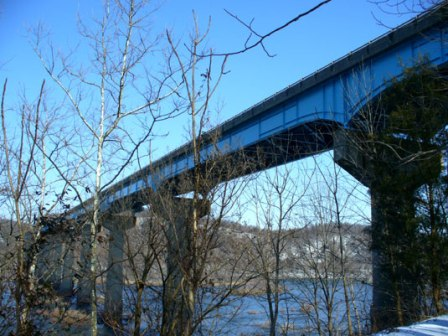 Click to Print Adobe PDF
Click to Print Adobe PDF
Summer 2009 - Vol.4, No.2
COMMUNICATION: THE INDISPENSABLE PART OF EMERGENCY MEDICAL SERVICES
The Norman Wood Bridge Incident: A Turning Point
Michael J. Reihart, D.O., F.A.C.E.P.
Sr. V.P. & C.F.O., Lancaster Emergency Associates
Ronald D. Baier, E.M.T.-P
EMS/Communications Center Manager,
Lancaster General Hospital
|
 |
 |
Introduction
The success or failure of an emergency medical services (EMS) response is highly dependent on the utilization of effective communications, and timely access to reliable information. To maximize survival rates and minimize disabilities during any mass casualty incident (MCI), it is vital to have rapid, seamless, and coordinated communications between first responders and first receivers. The ability of EMS personnel to communicate with other responders in real time is critical to establishing command and control at the scene of an MCI, maintaining event situational awareness, and operating effectively over a broad range of MCI types. Many of the logistical problems faced in MCIs are not caused by shortages of medical resources but rather by failures to coordinate and optimize their distribution.
An effective EMS response requires a moment-to-moment "situational analysis" and transmission of real-time information that reflects needs and available resources that can change suddenly and unexpectedly. A critical "sequential interdependence" exists: accurate information from the field about the incident, casualties, medical needs, triage, and treatment impacts the utilization and preparedness of resources such as ambulances, emergency departments (ED), hospitals, and intensive care units. Similarly, information on available and accessible hospital, ED, and ambulance resources can influence the management and disposition of victims at the scene.
During an EMS call, events, decision making, and resulting actions represent discrete teps that largely occur on a sequential basis as new information is presented. In a rural car crash, for instance, the crash occurs, the crash is detected, EMS is called and responds, EMS arrives and evaluates, additional resources (e.g., extrication services, helicopter) are called and respond, medical direction is sought and provided, treatment is administered, and patients are transported. Each segment in the EMS response presents an opportunity for delays. Each also creates opportunities to accelerate appropriate medical intervention through improved communications that enable some events, decision making, and actions to occur more quickly. Delays during EMS calls can cost tens of minutes, if not hours, during the patient's "golden hour," the time from the crash event to the start of intensive treatment.
Problems with communications are a frequent source of disaster scene and triage errors in small MCIs. In a study of pre-hospital triage and EMS communication performance, prospective data from resource physicians and retrospective data from tape recorded pre-hospital conversations were collected for 45 consecutive MCIs over a 9-month period.[1] Most of the MCIs were motor vehicle accidents and most patients were treated at a level 1 trauma center. Frequent errors included having multiple communicators on site (38%), misidentifying the number of victims (56%), and having unclear information for the resource physician (43%). Only 38% of events had pre-hospital triage information that was deemed entirely appropriate.
EMS communications systems need not be highly specialized or sophisticated to provide benefit. The major challenge in the design of such systems is to match the right equipment and protocols with the contingency systems and response plans of a given region. Another important consideration is the ability to assess and manipulate acquired information and communicate essential results where and when they are needed. Communication technologies are continuously evolving greater capabilities, and they are also increasingly affordable. With such advances, a natural question for the disaster management community to ask is: How can planning and technology help us create the most effective EMS response in a disaster?
Communications Challenges: From National to Local
The terrorist attacks of September 11, 2001 and other national disasters highlighted the need for improved emergency communications among federal, state, and local agencies. In 2008, the U.S. Department of Homeland Security (DHS) released the National Emergency Communications Plan (NECP). NCEP was developed in cooperation with over 150 public and private sector emergency communications officials with the goal of identifying emergency communications problems and solutions so that emergency response personnel at all levels of government and across all disciplines can communicate as needed. NECP is a strategic plan that establishes a national vision for the future state of emergency communications, sets national goals and priorities for addressing deficiencies in the nation's emergency communications structure, and provides recommendations and milestones for emergency response providers and relevant government officials to improve their communications capabilities. NECP is the nation's first strategic plan to improve emergency response communications and was designed to complement existing homeland security and emergency communications legislation, strategies, and initiatives. NECP defines three goals that establish a minimum level of interoperable communications and deadlines for federal, state, local, and tribal authorities [Table 1].
EMS in the Commonwealth of Pennsylvania
The need for effective emergency communications among state, county, and local responders is especially critical in Pennsylvania because of its Commonwealth local government structure. In addition to several state agencies, there are 67 county emergency offices and thousands of local police and fire departments, hazardous materials teams, and ambulance services that handle emergency situations throughout the Commonwealth. The Department of Health is the lead agency for EMS in the Commonwealth. The EMS system includes 16 regional EMS councils, Pennsylvania Emergency Health Services Council, the Pennsylvania Trauma Systems Foundation, and two Poison Control Centers. In Pennsylvania in 2007, approximately 51,000 EMS personnel and 983 licensed ambulance services responded to emergency calls involving over 1.8 million patients.[2]
- By 2010, 90 percent of all high-risk urban areas designated within the Urban Areas Security Initiative (UASI) can demonstrate response-level emergency communications within one hour for routine events involving multiple jurisdictions and agencies.
- By 2011, 75 percent of non-UASI jurisdictions can demonstrate response-level emergency communications within one hour for routine events involving multiple jurisdictions and agencies.
- By 2013, 75 percent of all jurisdictions can demonstrate response-level emergency communications within three hours of a significant event, as outlined in the department's national planning scenarios.
|
| [Table 1.] Primary goals of the National Emergency Communications Plan |
EMS in Lancaster County
Lancaster County, Pennsylvania, encompasses approximately 984 square miles and has a population of almost 500,000. Lancaster County is currently served by 21 transport ambulances and one non-transport hospital based ALS service, staffed by both paid and volunteer personnel. EMS activities in Lancaster County are coordinated by Lancaster County-Wide Communications (LCWC), which responds to a daily average of 580 9-1-1 calls and deals with a daily average of 1,090 emergency and non-emergency incidents. LCWC employs a staff of 75 dispatchers with an average of 15 on duty at all times. In addition, an administrative staff of 16 people provides support services such as quality assurance, training, radio maintenance, and database administration. In Lancaster County, EMS personnel responded to 76,142 dispatch calls in 2008, a daily average of 209 calls [Table 2]. [3]
When a 9-1-1 call is received at LCWC, the call is answered by a call-taker who enters pertinent information into the Computer Aided Dispatch System (CADS). The CADS then routes the call to the proper dispatcher based on the type of incident and the location. The county is divided into 4 geographic zones, plus Lancaster City, and one dispatcher covers each zone. There are four dispatchers working at all times. The CADS suggests to the responding dispatcher the units to be sent on the call and the dispatcher pages the required agencies. Almost all 9-1-1 calls are routed to a police dispatcher. If an emergency requires a response from a fire department or ambulance, the call is simultaneously routed to a second dispatcher who handles both fire and EMS dispatching.
| Incident Type |
Total Calls |
| Traumatic/injured |
6768 |
| Sick person |
6375 |
| Breathing difficulty |
5291 |
| Fall/injured |
4778 |
| Vehicle accidents |
3841 |
| Chest pain |
3692 |
| Unconscious person |
1746 |
| Psychiatric/emotional |
1719 |
| Heart problem |
1543 |
| Seizure |
1521 |
| Stroke/CVA |
1500 |
| Abdominal pain |
1350 |
[Table 2.] Commonest EMS calls in Lancaster County, Pennsylvania, 2008.
Source: Lancaster County-Wide Communications 2008 Annual Report. Available at www.lcwc.co.lancaster.pa.us |
The Norman Wood Bridge MCI: A Turning Point
The Norman Wood Bridge, named for a former member of the Pennsylvania House of Representatives, is one of over 200 bridges that cross the Susquehanna River, the longest river on the East Coast of the United States. Rising some 175 feet above the Susquehanna River, the Norman Wood Bridge carries Pennsylvania Route 372 between York County, Pennsylvania and Lancaster County, Pennsylvania [Figure 1].
 |
| Figure 1. The Norman Wood Bridge (PA-372) over the Susquehanna River. |
On the evening of October 27, 2002, seven members of a York County Amish family were severely injured when a passenger van slammed into the back of their horse-drawn buggy as they traveled westbound on the Norman Wood Bridge. Injured in the crash were a husband, wife, and five children, ranging in age from 3 to 11 years. The collision destroyed the buggy and threw all seven of its occupants onto the bridge. The accident resulted in the deaths of the 36-year-old father and two of the five injured children, ages 3 and 9 years. The van driver was uninjured and the horse died from the impact. Following an investigation, the van driver was cited for careless driving and driving without proper insurance.
The accident was categorized as a Class I MCI by EMS dispatchers [Table 3]. More than a dozen fire companies, ambulance, and rescue-helicopter crews from York and Lancaster counties responded to the crash, which happened just east of the York County line. The geographic location of the crash presented some unique challenges to EMS dispatchers and on-site personnel. Since the location of the crash was a section of highway located between York and Lancaster counties, it wasn't immediately clear which local authority was responsible for responding to the MCI. EMS units from both York and Lancaster counties ultimately responded, but the communications of each county team were held on different radio frequencies, leading to confusion at the crash site. Additionally, the radio communications of Lancaster County's own Fire and EMS teams were on two different frequencies (EMS on 33.60 and Fire on 33.72), which resulted in excessive transmission of unnecessary and often redundant messages.
The initial crash scene responders also lacked a unified command structure. First-arriving units were unsure of their respective roles and failed to immediately establish triage, treatment, and transport sectors. As a result, confusion existed regarding the number of injured persons, severity of injuries, transport destinations, and the capacity of local trauma centers. Other problems were related to the particular aspects of the bridge crash site. Initial reports indicated that one of the injured children had been thrown from the bridge to the river below. While this report eventually proved false, the misinformation led to an unnecessary diversion of rescue efforts to locate the supposedly missing child. The departure of some ambulance crews at the crash site was temporarily delayed by transport helicopters that had, for lack of a designated landing zone, landed directly on the bridge, blocking the roadway.
|
A mass casualty incident (MCI) is defined as an event in which the usual standard of care is compromised and the need arises to ration available resources. There are four levels of MCI:
- Level I. An incident involving 3 to 5 patients. Usually requires local resources only. A severe multiple-person motor vehicle accident requiring regionally available ambulances would be an example.
- Level II. An incident involving 6 to 10 patients. May require additional county and/or regional resources. An example would be a bus accident requiring ambulances from several towns.
- Level III. An incident involving 11 to 25 patients that overwhelms regionally available resources and may require state and/or federal assistance. An example would be a natural or man-made disaster.
- Level IV. An incident involving 26 or more patients that may require state and/or national resources. An example would be a major natural disaster or catastrophe affecting a large geographic area.
|
[Table 3.] Classification of mass casualty incidents |
The Aftermath: Review and Revision
A few months later, in January, 2003, members of the LGH Emergency Department, Trauma Center, Lancaster County EMS Services, Fire Department, and Lancaster County 911, held a multidisciplinary meeting to review the details of the emergency response to the Normal Wood Bridge MCI and to identify strategies to improve responses to future emergencies. Outcomes of the Norman Wood Bridge MCI were compared with emergency response standards established by the National Fire Protection Association, a source of consensus codes and standards intended to minimize the worldwide burden of fires and other hazards on the quality of life. The meeting included reviews of tapes and transcripts of communications generated during the Norman Wood Bridge MCI, interviews with original participants, and examinations of detailed maps of the disaster site and surrounding areas.
Prior to the Norman Wood Bridge MCI, the transmission of information to receiving facilities regarding the number of patients and the nature and severity of their injuries was the responsibility of transporting ambulance personnel. Following the implementation of the revised system, patient-related information is relayed to receiving facilities and to the physician-on-duty at the EMS Command Center by the on-site EMS Command Officer. This Officer is responsible for overall management and coordination of all personnel and resources related to the MCI and for ensuring that the functions of the EMS section (i.e. triage, treatment, and transportation) are accomplished. After the first arriving EMS unit initiates the command role, command may later be passed to a Field Supervisor or to the most qualified provider. In smaller MCIs and in the initial stages of large incidents, the EMS Command Officer may fill several EMS section roles such as Triage Officer. If the MCI escalates, or additional resources arrive, subordinate roles may be reassigned to other individuals.
The revised MCI response plan defines the position of the Transportation Officer, who secures transportation resources, maintains transportation records (which patients are transported to which facilities by which unit), coordinates patient loading on a priority basis, and coordinates with Medical Control to determine the status of receiving facilities. The Communications Officer makes contact with EMS Command and LCWC to determine which facilities are capable of accepting patients and the number and types of patients they can accept. He/she also communicates with receiving facilities and reports on the number, type and conditions of patients they will be receiving. The EMS Staging Officer works directly with the Transportation Officer to coordinate transport assets. He/she is responsible for establishing a staging area for ground ambulances and aircraft, maintaining a record of available EMS resources, and assigning resources based on the needs of the Transport section. An ideal staging area is located close enough to the MCI to be useful and effective but far enough away not to hinder operations.
Conclusions
Communication and information management are major challenges in MCIs. EMS teams must procure and coordinate resources and personnel despite often inadequate information regarding the actual nature of the incident, the needs of patients, and the capabilities of receiving facilities. The receipt of accurate, real-time information from the MCI site is imperative for Emergency Departments to anticipate workloads from ambulance arrivals, to prepare for interventions, and to coordinate staff and resources in the hospital. In this chaotic environment, communication plays a critical role in improving the EMS response and the outcomes of injured patients. The Norman Wood Bridge MCI highlighted the need for improvements in EMS communications and incident command in Lancaster County. The implementation of these and other improvements is an ongoing process of continuous improvement in the efficiency and effectiveness of the EMS response in Lancaster County.
References
[1] Johnson GA, Calkins A. Prehospital triage and communication performance in small mass casualty incidents: a gauge for disaster preparedness. Am J Emerg Med 1999 Mar;17(2):148-50.
[2] Pennsylvania Department of Health. Bureau of Emergency Medical Services. Annual Report, 2007. Available at
www.health.state.pa.us/
Neither Dr. Reihart nor any member of his immediate family have any relevant relationships to disclose with any corporate organizations associated with the manufacture, license, sale, distribution or promotion of a drug or device.
Neither Mr. Baier nor any member of his immediate family have any relevant relationships to disclose with any corporate organizations associated with the manufacture, license, sale, distribution or promotion of a drug or device.
Michael J. Reihart, D.O., F.A.C.E.P.
Sr. V.P. & C.F.O., Lancaster Emergency Associates
555 North Duke Street
Lancaster, PA 17602
717-544-4978
mjreihart@aol.com
Ronald D. Baier, E.M.T.-P
EMS/Communications Center Manager, Lancaster General Hospital
Sr. V.P. & C.F.O., Lancaster Emergency Associates
555 North Duke Street
Lancaster, PA 17602
717-544-5119
rdbaier@LGHealth.org